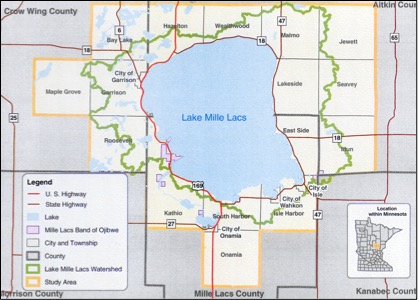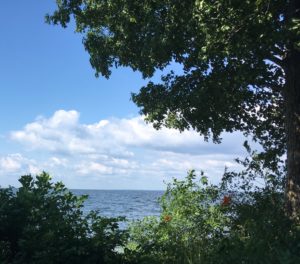About the Mille Lacs Lake Watershed
A watershed is an area of land that catches rain and snow and drains into a wetland, river, lake, or groundwater. Homes, farms, cabins, forests, small towns, big cities, and more are all parts of a watershed. Watersheds come in all shapes and sizes and can vary in size from millions of acres to just a few acres that drain into a pond.

A Big Lake and Many Jurisdictions
The watershed of Mille Lacs Lake encompasses more than 116,000 acres of land and 132,520 acres of water surface. The lake itself occupies 207 square miles, which is about 53 percent of the watershed’s area.
The watershed falls under the jurisdiction of three counties (Aitkin, Crow Wing, and Mille Lacs), the Mille Lacs Band of Ojibwe, and the towns of Garrison, Wahkon, and Isle. Several smaller lakes, mostly north and west of Mille Lacs, are also part of the watershed.
Long Water Residency
The Mille Lacs Lake Watershed has a small land area relative to its water surface area. Water enters the lake either through surface water flow, precipitation, or groundwater. Water exits the lake through a single outlet, the Rum River. These factors result in what is called “long water residency.” This means that it may take as long as 30 years for water entering the lake to exit the lake. Pollution carried into the lake with the water will also remain in the lake for a long period of time.
Explore Mille Lacs Watershed Activities, Natural History, and More

The Mille Lacs Lake Watershed Management Group regularly posts short articles that provide background information and steps you can take to preserve the watershed’s health. These articles are organized by topic in the list below; click a title to download a pdf.
About Watersheds
Add Your Voice to the Rum River Watershed Plan (December, 2021)
Watershed Comprehensive Water Planning (January, 2020)
Get To Know the Mille Lacs Lake and Rum River Watersheds (December, 2019)
What Are Watersheds, and Why Are They Important? (August, 2017)
Understanding and Conserving Our Natural Environment
Protecting Our Water – One Forest at a Time (July, 2023)
Keep It Clean Campaign Comes to Mille Lacs Lake (January, 2023)
The Big Role Insects Play in the Food Web (May, 2022)
RIM Conservation Easements (November, 2019)
God’s Work, Our Hands: Mille Lacs Lake Cleanup 2 (September, 2019)
A Visit to Mille Lacs Moraine Scientific and Natural Area (July, 2019)
Giving Thanks for our Lakes (January, 2019)
Wild Rice and Water Levels (September, 2018)
What Is the Deal with Wetlands? (June, 2018)
God’s Work, Our Hands: Mille Lacs Lake Cleanup 1 (September, 2017)
The Mille Lacs COMPASS Program
LET IT GROW: An Adventure in Lakeshore Stewardship (August, 2021)
Thank You, COMPASS Members! (November, 2018)
Meet a Silver Compass Member (August, 2018)
Healthy Land, Healthy Lake (July, 2018)
Mille Lacs’ Circle of Influence (March, 2018)
Watershed Tour (October, 2017)
Join the Mille Lacs Lake Watershed COMPASS Movement (May, 2017)
Shoreline Protection and Restoration
Drone Study Captures Mille Lacs Lake Shoreline (November, 2023)
Purple Loosestrife: A Pretty, Purple Predator (July, 2023)
Do-It-Yourself Projects To Protect Your Shoreline (July, 2020)
Avoiding the Tumble of Rip-Rap (March, 2020)
Adopt-A-Shoreline (May, 2019)
Native Shoreline Plants (April, 2019)
Along with Spring Comes Ice Heaves (May, 2018)
Plantings
Start Enjoying the Benefits of Native Trees! (February, 2021)
Salt-Tolerant Trees, Shrubs, Perennials, and Herbaceous Grasses (January, 2021)
Native Shoreline Plants (April, 2019)
Ready to Plant? (June, 2019)
Trees – Partners in Watershed Health (October, 2018)
Is it Time to Think About Spring & Summer Flowers Yet? (January, 2018)
Managing Runoff
Wahkon Stormwater Management Plan Open House (August, 2021)
Why Should I Care About Runoff? (March, 2019)
Five Ways to Reduce Nutrients in Lakes & Streams (January, 2017)
Reducing Nutrients and Phosphorus
Minnesota LakeBrowser Tool Provides Water Quality Data Captured by Satellite (December, 2021)
Following the Phosphorus in the Fall (October, 2019)
Don’t Let Your Septic System Freeze (December, 2018)
Managing a Healthy Septic System (February, 2018)
Controlling Chloride and other Chemicals
It’s Time To Get the Lead Out! (August, 2022)
We Raise Our (Stocking) Caps to Those Who Clear Our Roads (March, 2022)
Nine Smart Salting Tips That Protect Our Waters (January, 2022)
Help Reduce the Volume of Unregulated Chemical Pollutants in Our Waters (June, 2021)
Salt-Tolerant Trees, Shrubs, Perennials, and Herbaceous Grasses (January, 2021)
Smart Salting Protects Minnesota Waters (February, 2019)
Smart Salting Tips (December, 2017)
Managing Aquatic Invasives
New CD3 Boat-Cleaning System (September, 2020)
The Spiny Waterflea Invasion (February, 2020)
Twenty-nine sites hold “Starry Trek” (August, 2019)
Aquatic Invasive Species and What We Can Do (April, 2018)
MORE
Isle Students Build Birdhouses for Watershed Group (June, 2023)
The Mille Lacs Community of Stewards Picnic (June, 2022)
Silvopasture for Water Quality (November, 2017)
Educate Yourself! Opportunities Coming! (June, 2017)
A Plan for Your Forestland (April, 2017)
What Is a Best Management Practice (BMP)? (March, 2017)
Helpful Resources for Further Exploration
The Mille Lacs Lake Watershed Management Group works to provide interested landowners with the tools they need to make informed decisions when managing their property. Check out some of the resources provided below.
Workshops and seminars
Email us with questions: millelacswatershed@gmail.com
County SWCD and agency websites and resources
Aitkin County Soil & Water Conservation District – www.aitkincountyswcd.org
Crow Wing Soil & Water Conservation District – www. crowwingswcd.org
Mille Lacs Soil and Water Conservation District – www.millelacsswcd.org
Mille Lacs Band of Ojibwe – www.millelacsband.com
Minnesota Board of Water and Soil Resources – www.bwsr.state.mn.us
Minnesota Department of Natural Resources – www.dnr.state.mn.us
Minnesota Pollution Control Agency – www.pca.state.mn.
